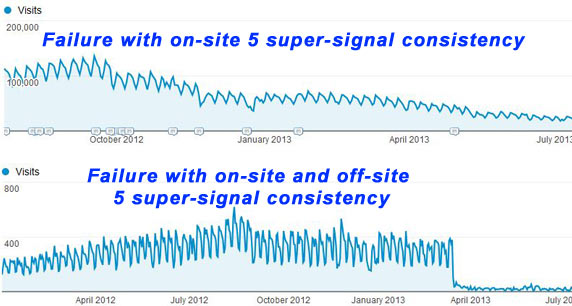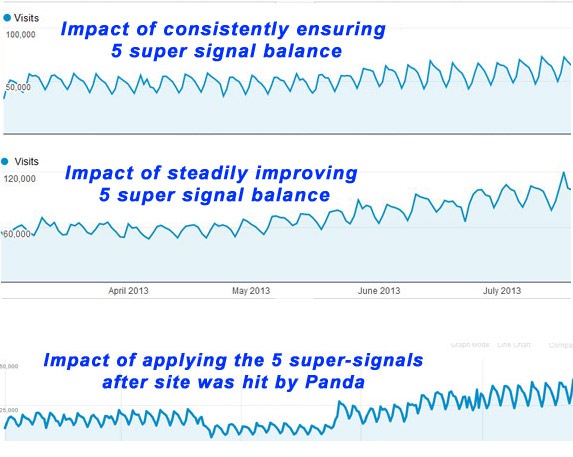The overwhelming majority of sites that I audit have been hammered by either Panda, Penguin, or both. Sure, there are some sites where the drop in rankings can’t even correlate to a known Panda or Penguin update. Some of those can track with fairly high confidence to other updates, such as the EMD update, and some just show a steady, more time-neutral drop in rankings.
Regardless of the source, by the time I am even partway through a forensic site audit, enough patterns have emerged to inform me that weakness exists across the same common range of problems. And whatever that range is, the patterns that stand out consistently in regard to what’s wrong can be summed up in five words.
- Quality
- Uniqueness
- Authority
- Relevance
- Trust
Whether it’s on-site or off, content level or code level, clearly identifiable as user experience-related or muddier as far as “is this truly a user experience issue?” — or some combination of these, it always comes down to the big five, or as I like to refer to them, “Super-Signals:” QUART.
All SEO Super Signals Matter
It’s important to understand that all signals count in SEO. And when it comes to the 5 super-signals, if you come up short in any one signal, you need to compensate for that shortcoming with even more effort across the other four. If you come up short in any one too much, or fail on too many of the five, your site will inevitably suffer.

Quality: It’s not an island unto itself
Create great content. Obtain high-quality links. Create a quality user experience. These are the oversimplified statements most often associated with the Q in QUART. When you bake critical thinking into it, we’re talking about “match the content to your business’ purpose AND searcher intent.” Take the time necessary to craft content to convey the highest level of relevance, to reinforce to the visitor that your brand is trustworthy, and you have the experience (authority) to provide the best solution for that unique need.
Quality here also means unique content – not something people can find seven thousand other places on the web. Which means something about your products or services, or something about the supporting services around those, or other authority or trust signals truly do set you apart from the competition all in ways that users are effortlessly able to see, read and identify with.
Users, users, users
Since SEO is really communicating that your site is a brand to be trusted (even if it’s a new site with only three pages and no existing customer base), and since that is determined at least partly by how people react to your presence, user experience really is golden for SEO.
Is it a high-quality user experience when your site’s page speeds (not through your personal browser stopwatch but through Google’s page speed, URIValet.com’s page speed and WebPageTest.org’s first pass speed) approach 15 seconds per page every day of the week? Or even if that only happened three days each month? No, it’s not.
And is it a high-quality user experience when you bombard them with 59 widgets on every page of the site? Nope. No way. No how.
And is it a high-quality user experience when you have 5,000 links in your main navigation bar? Or in your site-wide footer? Nope. Still not.
Quality needs to be seen from all angles in every aspect of SEO, calls to action, and ultimately, conversion flow.
Uniqueness without quality is (nearly always) useless
Basic SEO (yes, it really is a basic concept, not an advanced concept) dictates you need enough content that is truly unique to a given page, and within a given section of your site, and across your entire site, to even have a chance at ranking for any given phrase. Yet we can’t stop there. Within the unique content, you need to also communicate quality, relevance, trust and authority. Because no matter how many sites you’ve been able to create, or your SEO provider created that were pure garbage and “tricked” the search engine algorithms over the years, the days of those methods are rapidly winding down.
And while you still may be able to have a fake blog where every article contains four paragraphs and you stick three links into every article, and you have a link wheel that YOU believe is good enough for link signals to a site you really care about, that crap is going to take all of three seconds where a real human will know it’s a piece of crap.
Even if you THINK that’s helping you now, or if you need to recover from Penguin or a manual link penalty, or you want to avoid a future iteration of Penguin or a future manual penalty, you need to stop playing those games. Instead, recognize the long-term value of unique content that really does bake in QART.
Authority – Either You Are The Best or You Are Not
What are you doing to convey that “in this field, area, market, we are the go-to source for the most trusted quality” or in a way that conveys “these people are hacks?” Have you taken the time to ensure your blog article authors have a consistent web of multi-point presences across the Internet that reinforces the notion “this person knows what they’re talking about” or are all your articles written by “admin” and posted to “uncategorized”?
Have you established your brand authority signals through Publisher markup, or is one author given the entire control over authority signals as if they are the entire organization?
Are you taking steps necessary to reinforce authority through quality relevant customer relations on multiple channels online? Or are you bombarding everyone everywhere with low quality noise because “we need a presence”?
Holistic Relevance Wins
Nearly gone (they’re on the way out, people) are the days of “relevance means matching keywords from page to page, link to link, site to site… Nowadays, if you want the true win, you need to do what was always the best practice regarding relevance. Every angle you approach the need to match your content with searcher intent, every signal in the multi-signal evaluation of relevance on site at the content and code level, and every signal in the multi-signal evaluation of relevance from off-site points of reference needs that relevance to also meet the QUART litmus test.
Relevance applies to a web site’s purpose in regard to transactional or informational. And that needs to match relevance of searcher intent along the decision making timeline. Relevance applies to topical focus grouping (upside down funnels and silos). And it applies to your presence in social media. Are you obtaining social profiles on “all the sites” or those aligned with where your customers / clients / prospective customers / clients are spending their time.
Trust is all about User Experience
If you’re obtaining profiles on “all the sites” because you heard it’s important for ORM, do you realize you need to build every one of those up in an isolated organic way so as to prevent “low quality” presence signals?
Are you participating in social media as a one-way push of your own content? Or are you engaging your market / audience properly in a variety of ways that proves your brand has humans behind the brand? Humans that care, and want to interact in ways aligned with your market’s expectations?
Is all your content out around the web pure garbage that instills distrust? Are you spreading out or taking in guest posts that also reinforce trust? And build authority? Or just “because we heard guest blogging is the way to get links now”?
When people say bad things about your brand in social media, are you responding in respectful responsible ways, or are you going on the counter-attack? Or are you ignoring negative reviews entirely?
Have you matched up all your “location” directory profiles with the exact same NAP information? And does that match the NAP information you have on each of the unique location pages on your own web site? Or is it a complete mess that screams “I can’t trust if this is accurate, real or fake?”
Have you so polluted every signal on site, at the code level and off site with keyword stuffing that real humans scratch their head and say WTF? Or do you go about that work understanding that on-site you need consistency of signals without crossing into obnoxious? And do you go about the off-site link anchor effort in an abusive way or in a way that reflects the random nature of the larger web ecosystem?
SEO is an Ecosystem
In my audit work, all too often, I find situations where signals conflict. They counter each other, and often cancel out any value that would otherwise exist.
Note how, throughout this article, I interweave each of the five factors among the others? Note how I repeatedly reference “multiple signals”? That’s because it’s an ecosystem. When there is proper diversity, and each individual signal is one that reflects and represents a confirmation to all the other signals specific to any single aspect of SEO, you ensure a healthy and resilient ecosystem specific to your presence across the web.
If you don’t slow down the decision making process in your SEO efforts, and if you don’t then consider the interwoven nature of true SEO, you end up with a site that’s a complete mess, and an off-site presence that just makes it worse. Then you come to me and say “help – we’re in crisis”. Yet if you just slow down, and take the time necessary to realize these relationships and cross-point considerations, then apply QURTA to every decision, you’ll be light years ahead.
Applied with enough consistency over time, that’s a formula to win.

A Few Caveats
Note please, before proceeding, that anything I share in an SEO article or when I call on my experience providing SEO audits, it’s just that – my experience. You may very well find in your own unique situation or for any individual site, section of a site, or even a single page, that what I share, recommend or evangelize may be entirely out of alignment for you.
Also, the concepts I share can pretty much be matched across the board to things Matt Cutts or Maile Ohye from Google or Duane Forrester & Stephan Weitz from the Microsoft/Bing camp puts out. It doesn’t mean I blindly tow their line. It does mean, however, that anyone who claims these people are just spitting out false propaganda, well, I beg to differ from you.
Check that, I don’t beg. I don’t need to beg. In fact, I choose to call you out on your conspiracy theory driven anger generated discounting of the value these people bring to our industry. Again, that’s just my opinion, although it hasn’t failed me yet. So I’m sticking to it. For now. ![]()
Filtering Out The Exceptions
When I perform site audits, and get to the competitor landscape, I often find crazy things going on. Sites that technically “shouldn’t” rank, yet there they are.
Given how complex SEO truly is, and how complicated and how intricate the various search algorithms are, it’s pretty reasonable for me to understand why some garbage or low quality or less than ideally matched content shows up in organic search results. I don’t blame Google or bing for these shortcomings. If any of us out here in the trenches were to pretend we could do a better job, we really would be living in fantasy land. Just ask the good people at the now defunct Cuil search engine, or the Yahoo engine that is now an advertising picture frame for bing results.
So as you read this article, please keep in mind that there are clearly examples of search results where at least some of the URLs in those massively fall short of QUART in one or more ways.
But What About Big Brands?
Yes, I need to address big brands. “Google favors big brands”. We hear that frequently. But do they really? Well they do as far as how big brands can often get away with violating some aspects of QUART and still rank for a plethora of phrases. Why though? Because big brands have an inherent flexibility cushion.
Think of it this way – a site that has an extremely, extraordinarily high value assigned to it, such as trust, or authority, is going to have wiggle room when it comes to quality, uniqueness or relevance. This isn’t because Google bakes in a “they’re a big brand, so start them out with 50 bonus points” scenario. Or more precisely, such sites DO, in one way, get that bonus. Except they do so because of consumer actions.
Consumers have become so fascinated with, impassioned by, and otherwise loyal to big brands, as to automatically give those brands massive bonus points for authority and trust. And to enough of a degree, even relevance – at least in regard to products or services big brands have built their identity around.
So when a big brand site shows up for a non-brand phrase, they can often do so because of that existing weight in their favor.
Yeah but EDU and GOV sites are the holy grail for links right?
This is another worn out myth I battle on a regular basis. The notion that just because a link comes from a .edu or a .gov site somehow automatically means that link is more valuable. To start with, let’s get something straight. Similar to the way in which big brands have a built in expectation from consumers of their products or services, so to do .edu sites have a built in expectation from prospective students, existing students, faculty and parents. And legitimate government sites have that same built in expectation.
A real educational institution’s site or a real government site (not one created to fake out the search engines) has built-in trust, authority and relevance specific to the educational focus that school, college or university offers or to the governmental information and resources provided by that agency.
Lets go further though – a link from a .edu or a .gov site is only as valuable as the quality, uniqueness and relevance of the page the link is on, the section of the site that page resides within, and the authority and trust signals on and off site specific to that page and that section. Just having a .edu or .gov link is not itself going to give you magic bullet value if it doesn’t pass the QUART litmus test.
Critical Thinking – The Missing Ingredient
For a long while now, I’ve been harping on the notion of critical thinking and how vital it is (it is, after all, critical to the SEO process). And I do so for a legitimate reason. In order to get QUART signals aligned for maximum sustainable value, you absolutely need, can’t avoid, the application of critical thinking in any of your SEO decisions, strategy or tactics.
At every level, you need to recognize that rushing through any single task, or leaving a task to someone fresh out of SEO diapers, will inevitably result in the implementation of that task falling short due to either an inability, or unwillingness to slow down and consider the exponential ramifications of how that one task can cause ripple effects of problems across the many-layered signaling of topical focus or information architecture.
If you truly breathe long enough before making a decision about how to do any single SEO task, you can see where the topical focus in a page Title for example, is either reinforced or confused by the words you place in the URL, the H1, or navigational breadcrumb. And the overall topical focus will either confirm all of those, or muddy it all. And the same is true for inbound link signals and social signals as well.
It’s all related. And one action impacts all other actions in the SEO ecosystem.




